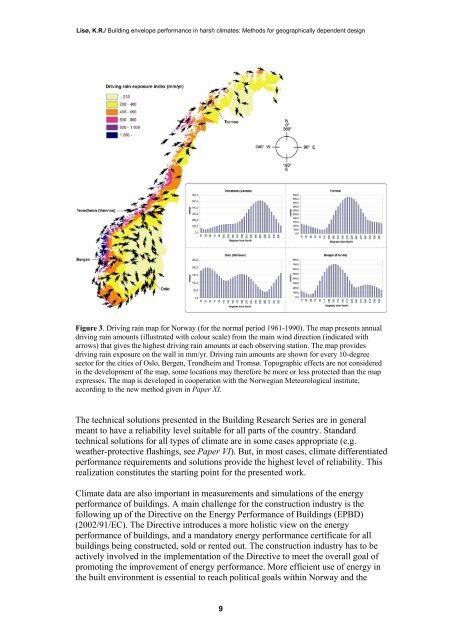Lisø PhD Dissertation Manuscript - NTNU
Lisø PhD Dissertation Manuscript - NTNU
Lisø PhD Dissertation Manuscript - NTNU
You also want an ePaper? Increase the reach of your titles
YUMPU automatically turns print PDFs into web optimized ePapers that Google loves.
<strong>Lisø</strong>, K.R./ Building envelope performance in harsh climates: Methods for geographically dependent design<br />
Figure 3. Driving rain map for Norway (for the normal period 1961-1990). The map presents annual<br />
driving rain amounts (illustrated with colour scale) from the main wind direction (indicated with<br />
arrows) that gives the highest driving rain amounts at each observing station. The map provides<br />
driving rain exposure on the wall in mm/yr. Driving rain amounts are shown for every 10-degree<br />
sector for the cities of Oslo, Bergen, Trondheim and Tromsø. Topographic effects are not considered<br />
in the development of the map, some locations may therefore be more or less protected than the map<br />
expresses. The map is developed in cooperation with the Norwegian Meteorological institute,<br />
according to the new method given in Paper XI.<br />
The technical solutions presented in the Building Research Series are in general<br />
meant to have a reliability level suitable for all parts of the country. Standard<br />
technical solutions for all types of climate are in some cases appropriate (e.g.<br />
weather-protective flashings, see Paper VI). But, in most cases, climate differentiated<br />
performance requirements and solutions provide the highest level of reliability. This<br />
realization constitutes the starting point for the presented work.<br />
Climate data are also important in measurements and simulations of the energy<br />
performance of buildings. A main challenge for the construction industry is the<br />
following up of the Directive on the Energy Performance of Buildings (EPBD)<br />
(2002/91/EC). The Directive introduces a more holistic view on the energy<br />
performance of buildings, and a mandatory energy performance certificate for all<br />
buildings being constructed, sold or rented out. The construction industry has to be<br />
actively involved in the implementation of the Directive to meet the overall goal of<br />
promoting the improvement of energy performance. More efficient use of energy in<br />
the built environment is essential to reach political goals within Norway and the<br />
9














![Diagnosis and FTC by Prof. Blanke [pdf] - NTNU](https://img.yumpu.com/12483948/1/190x245/diagnosis-and-ftc-by-prof-blanke-pdf-ntnu.jpg?quality=85)

